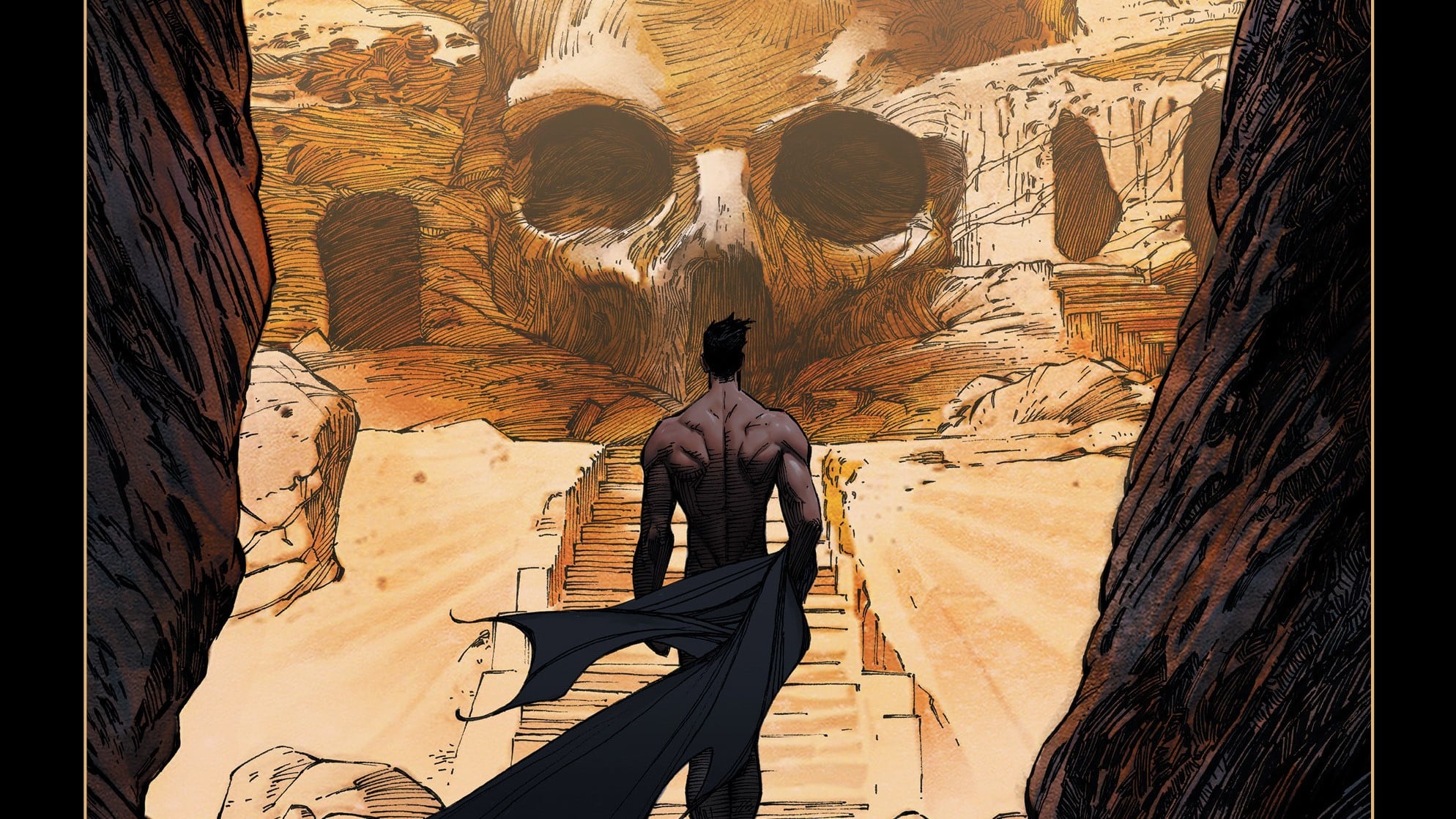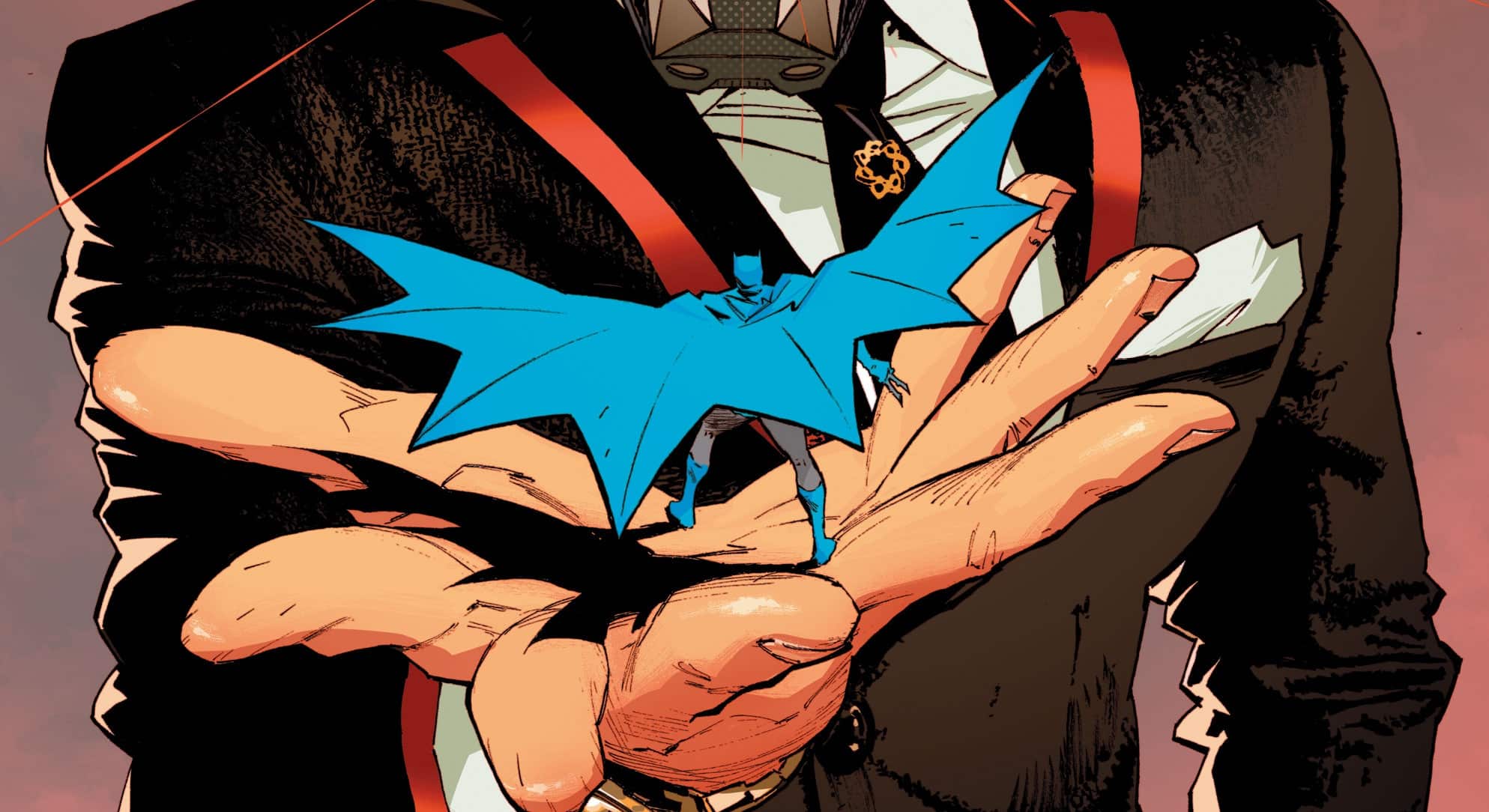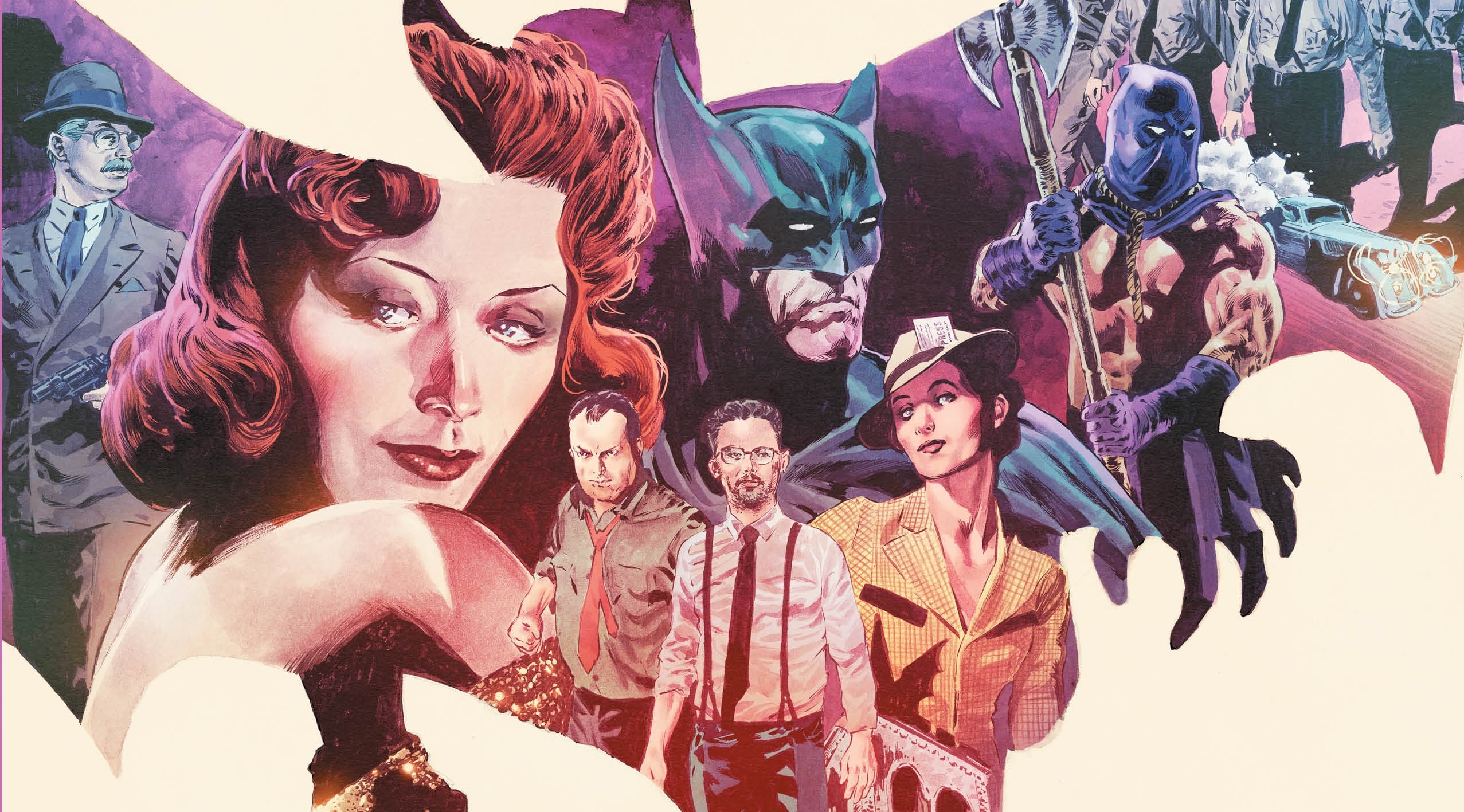The final act of “Gotham Nocturne” begins here. Stranded alone on the desert that is the apotheosis of all deserts, Batman must fight the Azmer demon inside him as Simon Hurt and his master Barbatos circle. Meanwhile, Renee Montoya continues her investigation into the death of GCPD members as the Question leads her down a grizzly path. The lead story of Detective Comics #1,081 is written by Ram V, drawn by Riccardo Federici and Steffano Raffaele, colored by Lee Loughridge and lettered by Tom Napolitano. In the backup, a support group meets, revealing many of the petty machinations of Dr. Hurt in a story written by Dan Watters, drawn by Hayden Sherman, colored by Triona Farrell and lettered by Steve Wands.
After nine issues, the four-part opening arc of the new Batman: The Brave and the Bold series wraps up, as this retelling of the first confrontation of Batman and the Joker reaches its bloodsoaked conclusion. So we go back and look at “Winning Card” as a hole, from issues #1, 2, 5 and 9, written by Tom King, drawn and colored by Mitch Gerads and lettered by Clayton Cowles.
And in a BatChat flashback, we go back and check out the first issue of Tom King’s current series featuring the Penguin. Oswald Cobblepot was out, having faked his death and retired to Metropolis. But now, the government has found him and wants him to take back the reins of crime in Gotham. Penguin #1 is written by Tom King, drawn by Rafael de Latorre, colored by Marcelo Maiolo and lettered by Clayton Cowles.
Will Nevin: If you think you might have an extra $135 laying around in July, man, I’ve got the thing for you.
Matt Lazorwitz: Oh, really? Do tell.
Will: David. Mazzucchelli. Year One. Artist’s. Edition.
Matt: Sign me up!
A Bat with No Name

Matt: So here begins the end game. Ram V has been building this run like a clockmaker, fitting each part together intricately. And the clock is now ticking. Batman has to reclaim himself before reclaiming Gotham. Montoya is on the trail that will lead her to the Orghams. Dr. Hurt is back and playing his own game with Bruce. While I wasn’t sure if we needed another player in this already packed series, Hurt coming back and absolutely playing on what he said way back in “Batman R.I.P.” is a great use of history and continuity.
Will: Not gonna lie here, I obviously got Hurt’s connection with the backup … but he’s in the main story as well? I guess that would explain the shadowy man in the desert.
Matt: Hurt is there at the beginning, when Bruce wakes up. He’s the one who sends him on his journey into the desert after Talia leaves him. And the man who helps him is Farhad I Parethes, the hero of the fable we saw Talia tell Damian. This is all circling back to that parable from issue #1,064. Farhad traveled this very desert, fighting an Azmer. We’re at a point where I kind of want to go back and read this whole run again, because I think there is so much laid out here subtly that is now going to pay off.
Will: Oh, I absolutely agree. The only bad thing about getting this on the show will be figuring out how to break it up. Despite everything being so good in this run, this might have been my favorite issue so far, with all the parts so wonderfully speaking to the whole. And the art? Nothing short of stunning.
Matt: Both artists here are firing on every cylinder. Riccardo Federici coming on from the “Knight Terrors” tie-in, a book we loved, does so much to make the surreal and otherworldly nature of the Aras Desert all the more stunning. And Stefano Raffaele, an artist who has popped in and out throughout this run, makes the more grounded Question segments pop.
Will: I loved how the Question pages were interwoven with the main story. Great way to pace the book.
Matt: Credit to colorist Lee Loughridge for doing two distinct sets of colors for both, while not making them so different as to throw the reader out of the next scene for a page or two. And not to leave anyone out, letterer Tom Napolitano does something similar with the word balloons here. The ones in Gotham are traditionally smooth, while the ones on Aras are just slightly irregular, not perfect circles, giving it an otherworldly feel. I “hear” that dialogue as slightly echoey, as if run through a very subtle filter. This is exactly how every aspect of a comic synthesizes just perfectly.
There are some themes that I just can read over and over again, and the indomitable will of Batman is one of them. And I think that is where we are going here. Batman, at his lowest, is going to have to face and triumph over impossible odds. And that is one of my favorite stories, no matter how many times I read it.
Oh, and just because I have to call it out, I really enjoyed this backup. We might get more of a reason as we get into later parts of it, but the idea that Dr. Hurt, while not screwing with Batman, just goes around and does terrible things to people because he can and for no other reason than glorious crapitude is great. He prides himself on being the devil, so why wouldn’t he?
Will: And the schemes were so evil — convincing a woman to fall in love, training someone to be a vigilante but setting them up to fail. Plus one mystery victim that was too terrible to get into. But I feel this is some sort of trap. One final torment for these poor people.
Matt: Oh, 100%. Hurt is just that kind of guy. He has wheels within wheels and torments within torments. And I like that he’s only appeared a handful of times, which makes his appearances have all the more power when he does show up. Maybe writers should take a cue from that when it comes to other villains, huh?
Will: That’s a Joker segue, isn’t it?
Buy Detective Comics #1,081 here.
Losing Card

Will: We covered the first two chapters of this way back when, and I think we were both of the opinion that it was bad. You know what? The back half sucked just as much — maybe even more! — than the front half. This was a story built on ultraviolence without a point, some experiment to turn Joker into Jason (from Camp Crystal Lake, not Todd) forced into the framework of the classic origin. And to top it all off, we had to take the softest, wrongest subtext of “oh, Batman and the Joker need each other!” and turn it into text.
Get all of the fuck the way out of here with this trash.
Matt: We have talked ad nauseum about Tom King and his love of form over function. But as he keeps doing it, we keep talking about it. The thing here is that the type of story he is trying to tell doesn’t work with his love of form. This is, for all intents and purposes, a horror story. I love horror. Whether it’s comics, movies, books or video games. Mitch Gerads’ eerie, black-eyed Joker is absolutely a horror creature more than a supervillain, anyway.
Part of what makes horror work is the unexpected. Even if you’re not working a jump scare, knowing going in that this is where the monster is takes away part of the horror. The first part of this has a proper scare. You don’t know for sure that black panels are Joker dialogue, and so when you get the page turn to Joker sitting on a bench with the little girl? It’s honestly eerie. But once we know, the black panels sort of kill the tension. And honestly, filling a nine-panel grid with four to five of those panels just feels like it’s padding the story out.
Will: That black box gimmick gets so old so quick. Visually, like everything else in this story, it’s sharp, but it is tiresome as hell. Gordon and his interaction with Batman is the other good and redeemable thing here in addition to the art. Everything else — including this Punisher-assed Batman — is a loss.
Matt: We’ve read three versions of Batman’s first meeting with Joker for the podcast, and when I read that King was going to be doing his own, I wanted to know what he would be bringing that was different. And making it a horror story is a novel approach. But novel doesn’t mean good. Batman here doesn’t really do much of any detective work, does he? He just endangers people and punches.
And to call it out, the release schedule on this thing is a disaster. What tension you might build up is completely killed by the gaps. This was supposed to kick off your new anthology, DC. I’m sure you lost readers when part 3 didn’t hit in issue #3, and I doubt they came back for it in issue #5. And then more trickled off when it was issue #9 before it concluded. I would love to see where the sales numbers were/are on this series versus Urban Legends by the end. While I’m sure each chapter of this arc saw a small spike, knowing comics sales trends? This issue is probably about 1/3 of what issue #1 was. If that.
Will: Editorial would have done better by continuing Urban Legends and actually relaunching Brave and the Bold as a team-up book, but they sure didn’t ask me. You mentioned this last chapter, and boy, it sure is weak. I can’t stand the thought of Alfred looking at Bruce and saying, “You didn’t kill Joker because you found a kindred spirit.” And while that’s not the actual dialogue, it’s not a bad paraphrase. WHAT?
Matt: I can accept Alfred wanting the Joker dead. We’ve seen that in a couple places, and if he had said Bruce should have made the exception for this particular monster, and Bruce said he couldn’t, I would have accepted that. But that bit of subtext as text, and Alfred saying it is just … dumb. And him saying it almost resignedly, versus calling Bruce on that bullshit if it was accurate? That is so woefully out of character. Alfred is who is THERE to call Bruce on his bullshit.
Will: It reminds me a lot of Riddler: One Bad Day in that King has some profoundly bad ideas he simply cannot be dissuaded from putting into books. Blech.
Buy Batman: The Brave and the Bold #9 here.
Penguin’s Flight

Will: OK, so that’s my fill of bad Tom King. But, you know, circling back to pick up Penguin #1? It’s not bad! There might not be a story in which he’s treated more seriously as both a mind and a physical threat — and it helps that this is probably the most normal artistic depiction as well. I profoundly do not like King’s vision of Joker as a horror trope. But a serious take on Penguin is not the worst thing ever.
Matt: I’ve been reading this as it came out, and while I have been waiting for the other shoe to drop and this to turn into a TOM KING COMIC (and there are a few moments in issue #2 that I didn’t love that we might talk about when/if we get there), this has been the best book King has done since Human Target. It’s a crime/conspiracy story, putting Penguin under the government’s thumb and him having to give up this life he made. It’s got the vibe of Unforgiven, but with a supervillain.
Will: And no one seems especially clean here. Penguin is forever the Penguin; there’s not going to be any redemption there. But the government abducting Oswald’s love to force him to do its bidding? That’s not hero stuff either.
Matt: Nope. The cameo by current archvillain of the DC Universe Amanda Waller (which is a problem, but not one that’s the fault of this book), pretty much seals the deal on that. Espinoza, returning from the footnoted Killing Time miniseries, reads like your typical government “ends justify the means” type. While she is the most likely candidate for who Batman is talking about in the opening pages when he says, “She … broke it all,” as the series has progressed more suspects for that turn have popped up. It’s keeping me guessing, which I like.
Will: If a mystery can keep you entertained, I know it’s good. You know, it strikes me that we may not have read — for the column and for the show — a writer as hit-and-miss as King. And maybe “hit and miss” is the wrong cliche there. When he’s good, he’s spectacular. When he’s bad, he’s dreadful. And there doesn’t seem to be anything in between.
Matt: Very true. There is usually a glimmer of spectacular King in dreadful King, and vice versa. And he absolutely has a talent, no matter which version you’re getting, of picking the best artists in comics to work with. Rafael de Latorre might not be as much of a household name as Mitch Gerads or Greg Smallwood yet, but his work here is excellent. His Penguin is still recognizably Cobblepot without leaning into either the Burgess Meredith or Danny DeVito caricature. He has a really strong look, and his violence is gritty without going so far as to be off putting.
Will: Violence can often be more effective when it’s only hinted at — everyone is so clearly petrified of Oswald in this story, and to that point, his poor tailor’s inner monologue is chilling. But he doesn’t spring into that savagery until the final page, which makes it so much more interesting than the wanton gore in “The Winning Card.”
Matt: I do feel I need to call out the glimpse of the King we don’t like in this book, because it is one of the things I find most tiresome in his work, up with the exploitation of nine-panel grids and his reliance on naming every place after a creator. The use of grawlixes in King’s work is excessive. It is the one thing that threw me out of the book. You can argue for verisimilitude, that people swear like this and you can’t include those actual swears and maintain the equivalent of a PG-13. But there are ways around it that don’t drown the page in symbols. It just feels self-indulgent.
Will: It sure as fucking, pissing shit did. Can’t even read some of the balloons it got so bad.
Bat-miscellany
- This week’s BatChat podcast features three small inter-Bat title crossovers from the early ’90s, when there were only three Bat titles, if you can believe that!
(Disclaimer: As an Amazon Associate, ComicsXF may earn from qualifying purchases.)







